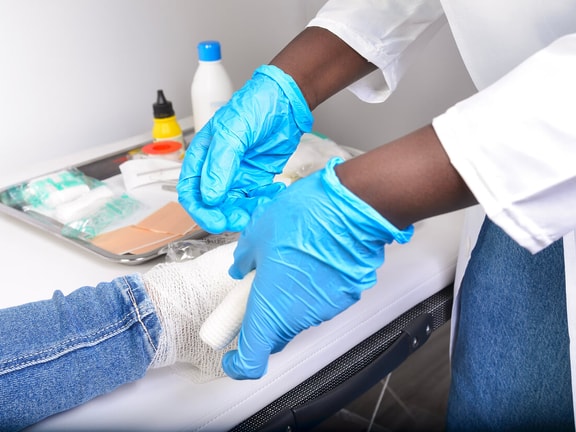Understanding Denuded Wounds: A Practical Guide for Home Health Providers
June 9, 2025
8 min. read

Denuded wounds can be hard on patients and challenging to treat in the home setting. These wounds—defined as the loss of the epidermis, often caused by friction, moisture, or medical adhesives—require careful, consistent management to support healing and prevent complications.
As medically complex patients remain in home care longer, clinicians are seeing more cases of denuded skin, especially in vulnerable areas affected by incontinence or frequent dressing changes.
In this article, we’ll review how to identify denuded wounds, understand their most common causes, implement evidence-based treatment strategies, and document findings clearly and accurately across care visits.
What Is a Denuded Wound?
Denuded wounds occur when the skin’s outermost layer, the epidermis, is removed, exposing the sensitive dermis underneath. These wounds often look red, shiny, and weeping, and patients typically describe them as painful or tender to the touch.
Unlike pressure injuries or ulcers, denuded wounds are typically irregular in shape and result from chemical, mechanical, or moisture-related damage, not prolonged pressure.
Common features of denuded wounds include:
Red, shiny, and weeping skin
Irregular (non-linear) borders
Pain or sensitivity at the site
Absence of necrotic tissue
This type of wound is commonly associated with incontinence-associated dermatitis (IAD), medical adhesive-related skin injury (MARSI), or skin stripping from dressing removal.
Common Causes of Denuded Wounds in Home Health
In the home setting, patients often face risk factors that increase the likelihood of skin breakdown, especially older adults or those living with chronic conditions. For these individuals, even small changes in hygiene, mobility, or medical device use can trigger denudation.
Below are three of the most common causes of denuded wounds in home health care:
1. Moisture-Associated Skin Damage (MASD)
Prolonged exposure to urine, feces, wound exudate, or perspiration can weaken the skin’s protective barrier, increasing the risk of denudation. This type of skin damage is prevalent in patients who are incontinent, have limited mobility, or are recovering from illness or surgery at home.
Incontinence-associated dermatitis (IAD) is a common form of MASD. It often presents as diffuse redness with irregular borders and superficial erosion.1
Skin damage can progress quickly without consistent cleansing and application of barrier creams or ointments.
Extended exposure to moisture between episodes of incontinence is a key contributor to breakdown.
2. Medical Adhesive–Related Skin Injury (MARSI)
The frequent application or improper removal of medical adhesives (such as ostomy wafers, tapes, or wound dressings) can strip the epidermis and result in denuded skin. MARSI is especially common when adhesives are removed without a barrier wipe or left in place for too long.
MARSI risk increases with age, fragile skin, or frequent dressing changes in post-acute or long-term care patients.
Studies suggest that MARSI affects up to 15 percent of patients receiving long-term adhesive treatment, particularly in frail or elderly populations.2
3. Friction and Shear
Mechanical forces from repositioning, medical equipment, or poorly fitted devices can gradually wear down the skin’s surface. Over time, this repeated friction can lead to progressive skin breakdown in vulnerable areas.
Common sources include catheters, braces, oxygen tubing, or frequent movement across bedding or wheelchair cushions. Denuded wounds caused by friction and shear often develop on the sacrum, buttocks, and inner thighs, which are already at risk due to moisture and limited mobility.
Treatment Strategies for Home Health
Managing denuded wounds in the home setting requires a balance of clinical best practices and real-world adaptability. Treatment should address the underlying cause while protecting the skin and creating an environment that supports healing. Plans must also be realistic for caregivers and patients to carry out between visits.
Here are four key strategies home health clinicians can use to manage denuded wounds safely and effectively:
1. Moisture Management
Excessive moisture is a common driver of skin breakdown, particularly in patients who are incontinent or have excessive perspiration or wound drainage. To help protect the skin and prevent denudation:
Use pH-balanced cleansers that won’t irritate sensitive skin.
Apply moisture barriers (such as zinc oxide or petrolatum-based creams) after each incontinent episode.
Encourage toileting schedules and consider switching to absorbent briefs made with breathable materials.
2. Minimize Adhesive Trauma
Frequent dressing changes can put fragile skin at risk, particularly when adhesives are applied or removed without proper precautions. To reduce trauma and support healing:
Choose low-adhesion or silicone-bordered foam dressings that protect the wound without damaging surrounding skin.
Use adhesive removers or skin barrier sprays during dressing changes to help prevent skin stripping and reduce discomfort.
3. Reduce Friction and Shear
Friction from movement, repositioning, or poorly fitted medical devices can gradually break down the skin and contribute to denudation. These forces are particularly problematic in areas where the skin is already vulnerable due to moisture or pressure. To help protect at-risk areas:
Teach caregivers safe repositioning and transfer techniques to reduce drag and skin stress.
Use breathable, non-adherent materials or padding in high-friction zones.
Regularly assess device fit and placement to prevent rubbing or localized irritation.
4. Monitor for Infection
While many denuded wounds heal without complications, clinicians should stay alert for signs of infection, particularly in patients with compromised immune systems or chronic conditions. Early identification can prevent delays in healing and reduce the risk of escalation. Watch for:
Increased redness, warmth, or swelling around the wound
Pain, odor, or purulent drainage
Delayed healing or changes in wound appearance
Follow wound cleansing protocols, and apply antimicrobial dressings if ordered by the supervising provider.
Case Example: Managing a Denuded Wound at Home
To bring these strategies into focus, here’s a real-world example of how one home health team identified, treated, and resolved a denuded wound, while adapting care to the patient’s environment and needs.
Patient background
A 78-year-old woman receiving home health services following hip surgery developed a denuded area over the sacrum. The wound measured 3 cm x 2 cm and appeared red, shiny, and weeping with irregular borders. The patient was incontinent and had experienced several days of diarrhea, contributing to moisture-related skin breakdown.
Plan of care
The home health nurse initiated a skin protection protocol using zinc oxide barrier cream, which was applied after each incontinent episode. Incontinence pads were switched to a breathable, high-absorbency brand to improve moisture control. The wound was covered with a silicone-bordered foam dressing, and an adhesive remover spray was used during dressing changes to minimize additional trauma. The patient’s caregiver was educated on gentle cleansing techniques and timely pad changes.
Outcome
By week two, the wound showed signs of reepithelialization, with reduced weeping and improved skin integrity. The patient reported decreased discomfort. By week four, the wound was fully resolved, with no signs of infection or further breakdown.
How to Document Denuded Wounds
In home health, where multiple clinicians may be involved across visits, clear and consistent documentation is essential for ensuring safe, effective care. Accurate wound descriptions support clinical decision-making, promote continuity, reduce the risk of delays or miscommunication, and help maintain regulatory compliance.
Because denuded wounds result from moisture, friction, or mechanical forces—not sustained pressure—they should not be staged as pressure injuries. Instead, document based on visual and clinical presentation.
Be sure to include:
The term “denuded” to distinguish it from pressure injuries or ulcers
Contributing cause, such as incontinence, adhesive trauma, or friction
Location and size of the wound (length × width in centimeters)
Depth, noting whether it involves only the epidermis or extends into the dermis
Wound bed characteristics, such as color and drainage
Periwound condition, including erythema, maceration, or tenderness
Interventions used and patient or caregiver response
Any education provided to support home-based wound care
To support consistency across the care team, consider using a standardized tool such as the Incontinence-Associated Dermatitis Intervention Tool (IADIT).
Clear, detailed documentation not only guides treatment—it helps ensure that every clinician involved is working from the same shared understanding of the wound’s status and progress.
Supporting Healing Through Consistent Care
Denuded wounds may appear superficial, but their impact on patient comfort, healing outcomes, and care coordination can be significant. Addressing these wounds effectively in the home setting requires clinical precision, thoughtful planning, and seamless communication across the care team. With a proactive, well-documented approach, clinicians can help prevent complications, reduce discomfort, and support faster recovery—right where patients need it most.
When home health nurses need to act quickly and confidently, having access to trusted, evidence-based guidance is key. The Medbridge Clinical Procedure Manual offers step-by-step instructions and video demonstrations for wound care and other high-priority skills.
Designed specifically for home health clinicians, this mobile-friendly resource helps standardize care, boost confidence in the field, and ensure every patient receives the highest quality support, even in the most complex situations.
References
Doughty, D., Junkin, J., Kurz, P., Selekof, J., Gray, M., Fader, M., Bliss, D. Z., Beeckman, D., & Logan, S. (2012). Incontinence-associated dermatitis: consensus statements, evidence-based guidelines for prevention and treatment, and current challenges. Journal of wound, ostomy, and continence nursing : official publication of The Wound, Ostomy and Continence Nurses Society, 39(3), 303–317. https://pubmed.ncbi.nlm.nih.gov/22572899/
Konya, C., Sanada, H., Sugama, J., Okuwa, M., Kamatani, Y., Nakagami, G., & Sakaki, K. (2010). Skin injuries caused by medical adhesive tape in older people and associated factors. Journal of clinical nursing, 19(9-10), 1236–1242. https://pubmed.ncbi.nlm.nih.gov/20345829/





